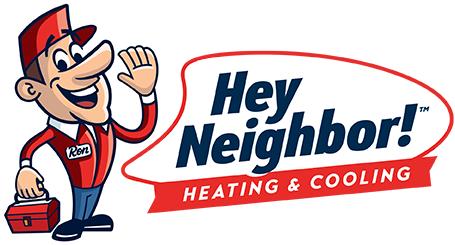We use a lot of technical jargon in the heating and cooling business you might not understand. While Hey Neighbor’s technicians are technical wizards who really know their stuff, folks who aren’t in the industry aren’t familiar with our often-perplexing verbiage. It’s interesting stuff for us, for sure, but it’s probably boring for you!
Instead of a tedious lecture, let’s make learning fun today! We’re going to explain many of the commonly-used acronyms (groups of letters) associated with our industry. We’ll give you not only each term’s definition, but also a fun, simple explanation for each one. We promise to try not to put you to sleep in the process.
AC
What’s that? There’s a good chance you know this one already. AC is short for Air Conditioner, one of the two primary devices that control your home’s temperature.
What does it mean? An air conditioner cools your home’s air by passing it over refrigerated coils and then distributing the cooled air throughout your airspace via the system of ductwork. It’s the thing that keeps you from sweating in Northeast Ohio’s muggy summer months.
AHRI
What’s that? The Air Conditioning, Heating, and Refrigeration Institute is the industry association that develops standards for certifying and measuring product performance.
What does it mean? They’re the heating and cooling quality control people. They help ensure your furnace and air conditioner are what they claim to be and follow the standards they’re supposed to follow.
BTU
What’s that? BTU is short for British Thermal Unit, a measurement of heat energy. The higher your system’s BTU rating, the greater its heating capacity.
What does it mean? It measures how well your system can heat your home.
CO
What’s that? CO is the chemical acronym for Carbon Monoxide, a colorless, odorless, and toxic flammable gas produced when carbon burns with insufficient air.
What does it mean? It’s invisible, poisonous, airborne stuff that can kill you. As fun as we’re trying to make this, we’re not joking around here. If you haven’t had your furnace inspected in a while, and your heat exchanger is leaking CO gas, your family could be in danger. Be safe – have our techs out to take a look.
CFM
What’s that? It stands for Cubic Feet per Minute, a measurement of airflow volume in cubic feet.
What does it mean? It measures how well your air is flowing. The higher the CFM number, the greater the air volume moved through your ductwork by the system.
EER
What’s that? It’s your air conditioner’s Energy Efficiency Ratio, the ratio of BTU to power input that measures its cooling capacity.
What does it mean? The higher your unit’s EER rating, the more energy-efficient it is. In other words, it’s a number that tells you if you’re paying too much to cool down your place.
EPA
What’s that? The Environmental Protection Agency is part of the federal government that enforces environmental regulations to protect our health and the environment.
What does it mean? Among other things, they made the labels that tell you how efficient that shiny, new furnace is and how much it’ll cost each year to run it.
HVAC
What’s that? HVAC is short for Heating, Ventilation, and Air Conditioning. Simple, eh?
What does it mean? The term refers to all the systems used in your home to move air between areas and the temperature adjustment of your space. Your HVAC system’s primary responsibilities are to keep you warm and cozy in the winter and cool and comfy in the summer.
kW/kWh
What’s that? A kilowatt and a kilowatt-hour might sound like the same thing, but they’re not quite. They’re related units of measurement, but the difference between kW and kWh is that kW is the electricity usage rate and kWh is the amount of electricity used.
What does it mean? The kilowatt-hour is most commonly used as the number you see on your monthly energy bill. It’s the amount of energy delivered to your home by your electric company. A kilowatt is 1,000 watts of electrical power.
MERV
What’s that? It’s your filter’s Minimum Efficiency Reporting Value, which describes the size of the holes in it that allow air to pass through it.
What does it mean? The higher your filter’s MERV rating, the higher its efficiency. A filter with a low MERV number isn’t going to do a great job of stopping allergens from getting sent back into your home’s airspace. You don’t want that.
NEC
What’s that? The National Electrical Code. It’s the set of requirements that ensure electrical installations are safe for people and property.
What does it mean? In addition to safety, the NEC provides the standards that keep electrical wiring in the USA much neater and far more reliable than in unregulated countries. Be glad we don’t suffer from wiring nightmares like this!
R-22
What’s that? Geek-speak, coming at you! R-22 is Refrigerant-22, the halocarbon compound CHClF2 (monochlorodifluoromethane). In the number 22, the second 2 is the number of fluorine atoms in the compound.
What does it mean? It’s what was used to cool a home’s air in residential air conditioners in years past. It was discontinued in 2010 due to new environmental standards set by the EPA.
R-410A
What’s that? As above, it’s Refrigerant-410A, a chlorine-free refrigerant that meets the new environmental standards set by the EPA.
What does it mean? It’s the stuff that newer air conditioners use to cool your home’s air. R-410A is better for the environment than R-22, and that’s a good thing.
SEER
What’s that? The Seasonal Energy Efficiency Ratio was developed by the government to measure energy efficiency for air conditioners.
What does it mean? It’s that bright yellow tag you see on your outside condenser unit. The higher the SEER number, the more energy-efficient the AC unit.
TMYK
What’s that? The More You Know!
What does it mean? Whew! It means that was a lot of heating and cooling jargon to take in at one time. We hope you learned some valuable things today that’ll help you make better-informed decisions when it’s time to repair or upgrade your heating and cooling system – you know, to save you lots of money and keep your family comfortable and safe!


Comments are closed